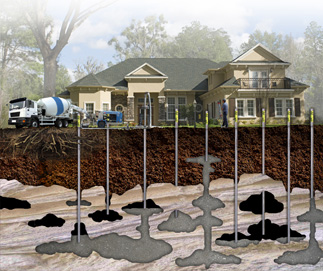Sinkholes are naturally occurring events caused by the breakdown of the limestone bedrock layers that compose the basis of our underlying soil structure. As rains and climatic events occur the water filters through the soils and limestone layers becoming acidic and begin breaking down the limestone layers causing voids and eventual collapse of the soils. Changes in the levels of the underlying aquifers and water run off also creates voids in the underlying layers.
Signs of Sinkhole activity
- Physical depressions or holes in your property
- Stair step cracks and Horizontal cracks in walls
- Stucco cracking and delamination
- Uneven floors
- Windows and Doors sticking or binding
- Drywall seperations

Solutions: Southern Coast Foundation Systems can analyze your problem and recommend a Geotechnical Engineer to survey the area and recommend a repair solution.
Sinkholes can be repaired often times by several methods. Grouting, both Chemical and Cementitous Injection, and Underpinning methods. Often times Sinkhole repairs will require several combined methods of repair to restabilize the soils and fill the voids.
Grouting Specifications for Sinkholes:
The grouting specifications are a basic guideline that is typically provided by the soils engineer for the remediation of the sinkhole condition.
Injection Point Spacing – The injection point spacing is usually determined by the soil conditions and the consistency of the grout material used. In certain cases a larger spacing interval can be utilized when combined with a higher slump range.
Injection Point Spacing – The injection point spacing is usually determined by the soil conditions and the consistency of the grout material used. In certain cases a larger spacing interval can be utilized when combined with a higher slump range.
Configuration – The injection points are typically installed on an alternating vertical and angled pattern. Angled points can be used to help direct the grout flow under the center of an existing structure.
Depth Range – The estimated depth range is based on the information collected from the Standard Penetration Test Borings. It is not uncommon to have a several foot difference in the depth to rock when comparing one boring location to another.
Slump Range – A Slump Test will define the thickness or consistency of the grout material. This test will measure in inches how much the grout material will sink or “slump” when a cone shaped mold confining the grout is removed. The slump range indicates what the allowable grout consistency can be as it is injected to treat the sinkhole.
Compressive Strength – The compressive strength will indicate how strong the grout material will need to be after a specified curing period. Most engineers will test samples of the grout material by measuring how much force is required to “break” the cured samples.
Injection Pressure – The injection pressure indicates the recommended pumping force that will be required at the point of injection to push the grout into the ground to seal off the limerock and re-compact loosened soil zones.












